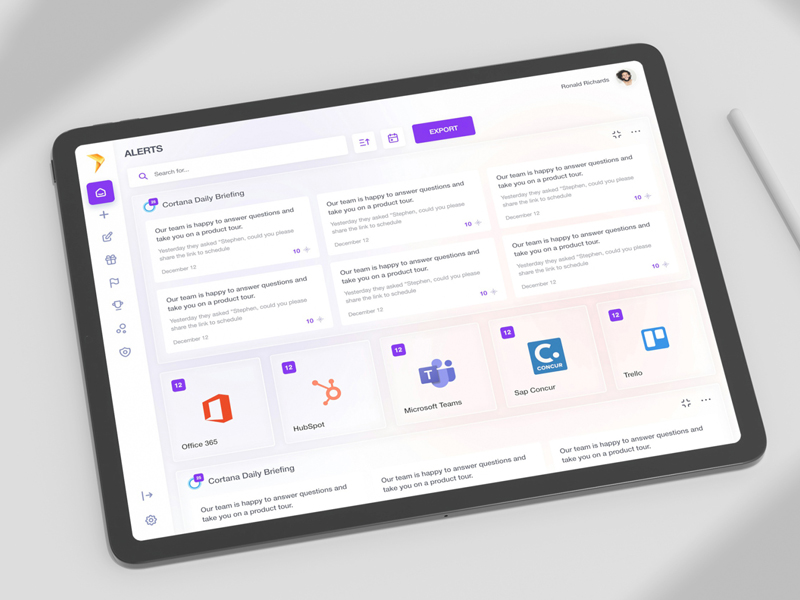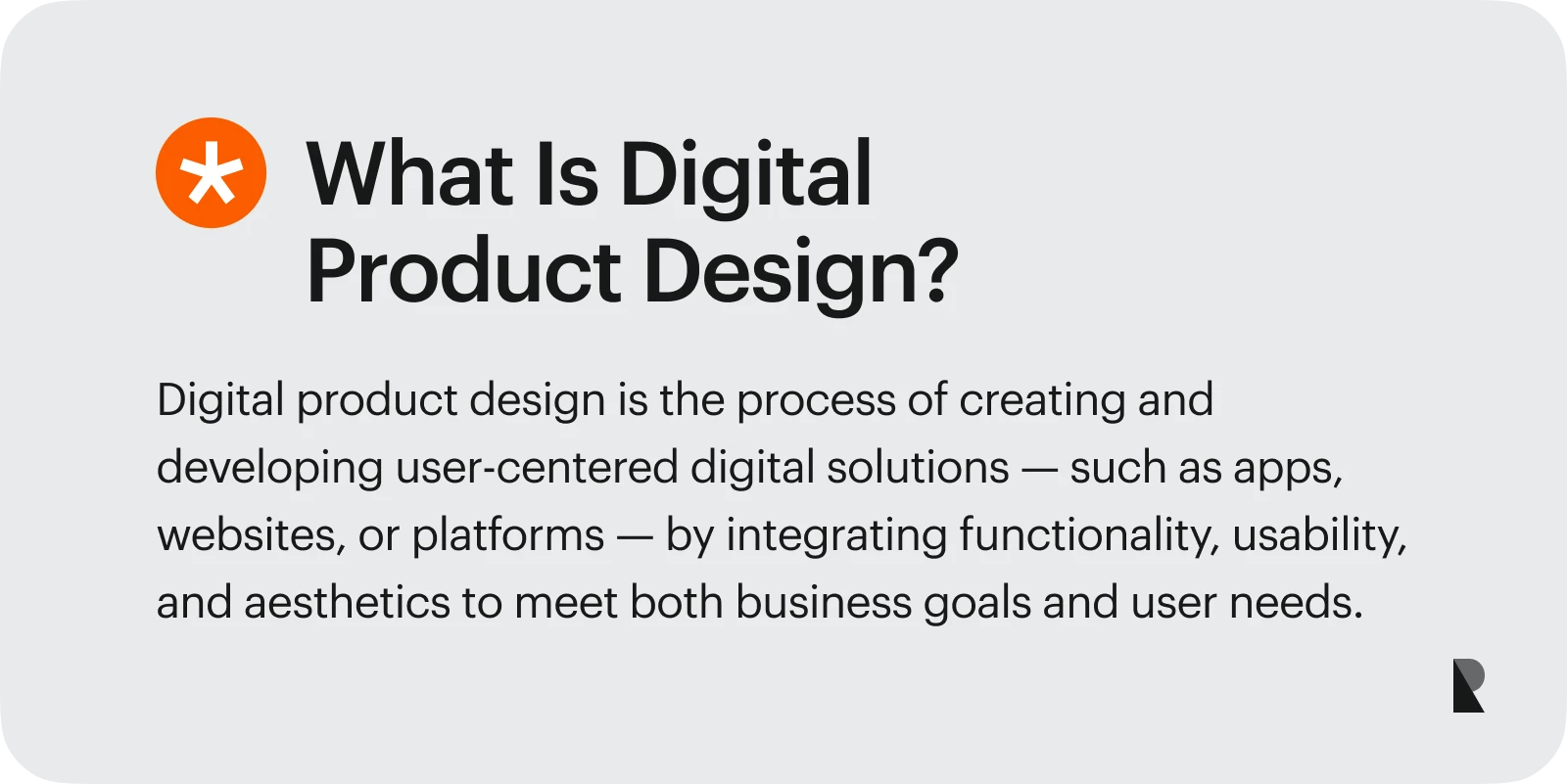
Digital product design is central to how we interact with technology today. Every mobile app we download, every SaaS platform we rely on, and every e-commerce checkout we complete is shaped by countless design decisions. These choices define how practical, intuitive, and human the product feels. Digital product design is no longer optional for businesses — it’s a direct driver of growth, customer loyalty, and competitive advantage.
This article will help you explore digital product design in depth. We’ll define what it means in today’s context, walk through the product design process, highlight the role of product designers, and look at how great design impacts user experience and business success. Along the way, we’ll try to address key challenges, compare product design to UX design, and underline why hiring the right UX design agency can make all the difference. Let’s get started.
Defininf Digital Product Design
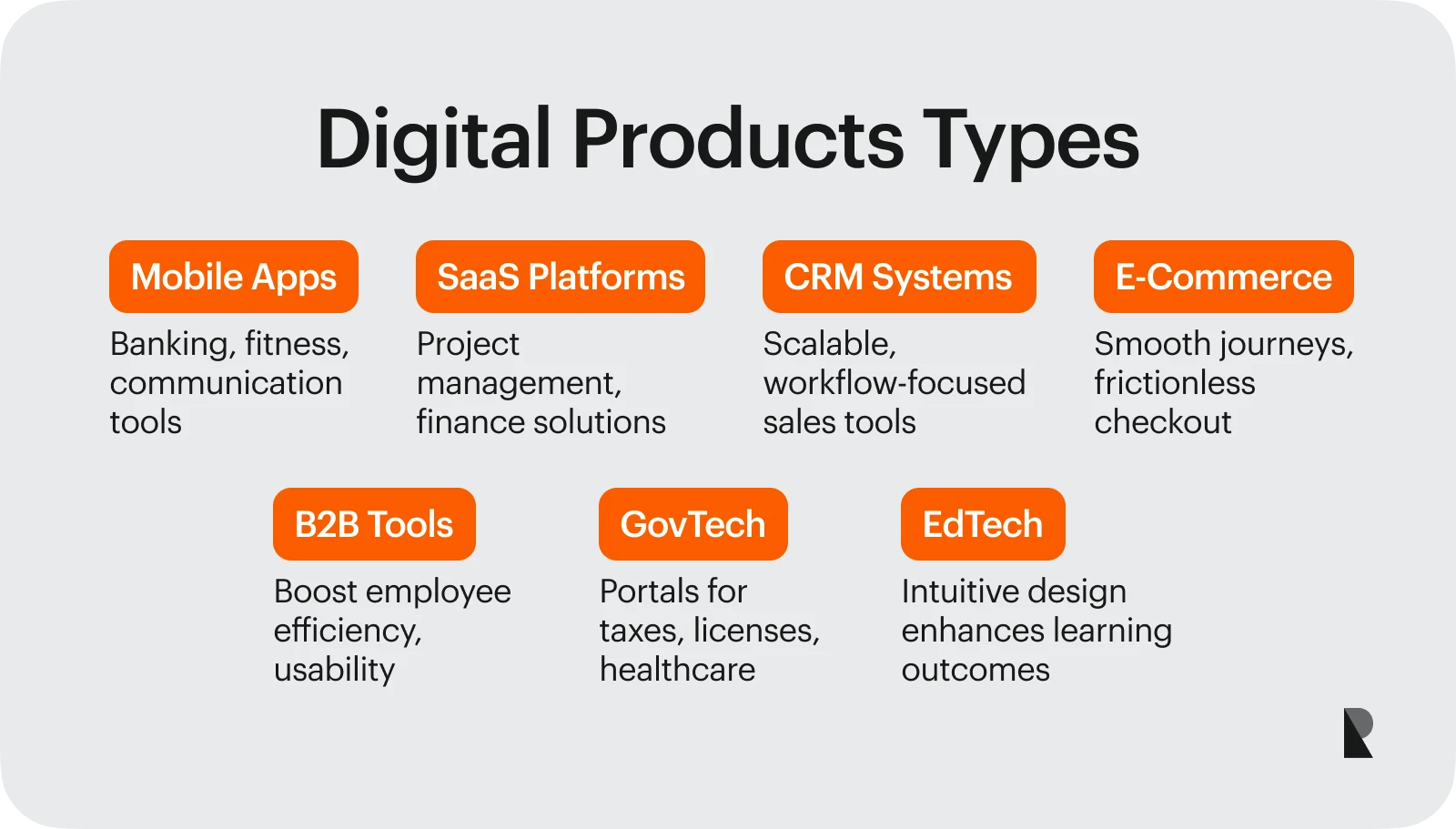
At its core, digital product design involves creating functional, engaging, and user-centric digital products. These can be anything from a mobile app to a large-scale enterprise tool. What unites them is that their design involves much more than making things look attractive. It’s about creating solutions that meet business goals while addressing user needs.
Digital product design includes several interconnected elements, such as user experience (UX), user interface (UI), information architecture, research, and testing. Together, these design elements guide how the end user interacts with the product and how satisfied they feel throughout the design process.
Examples of digital products
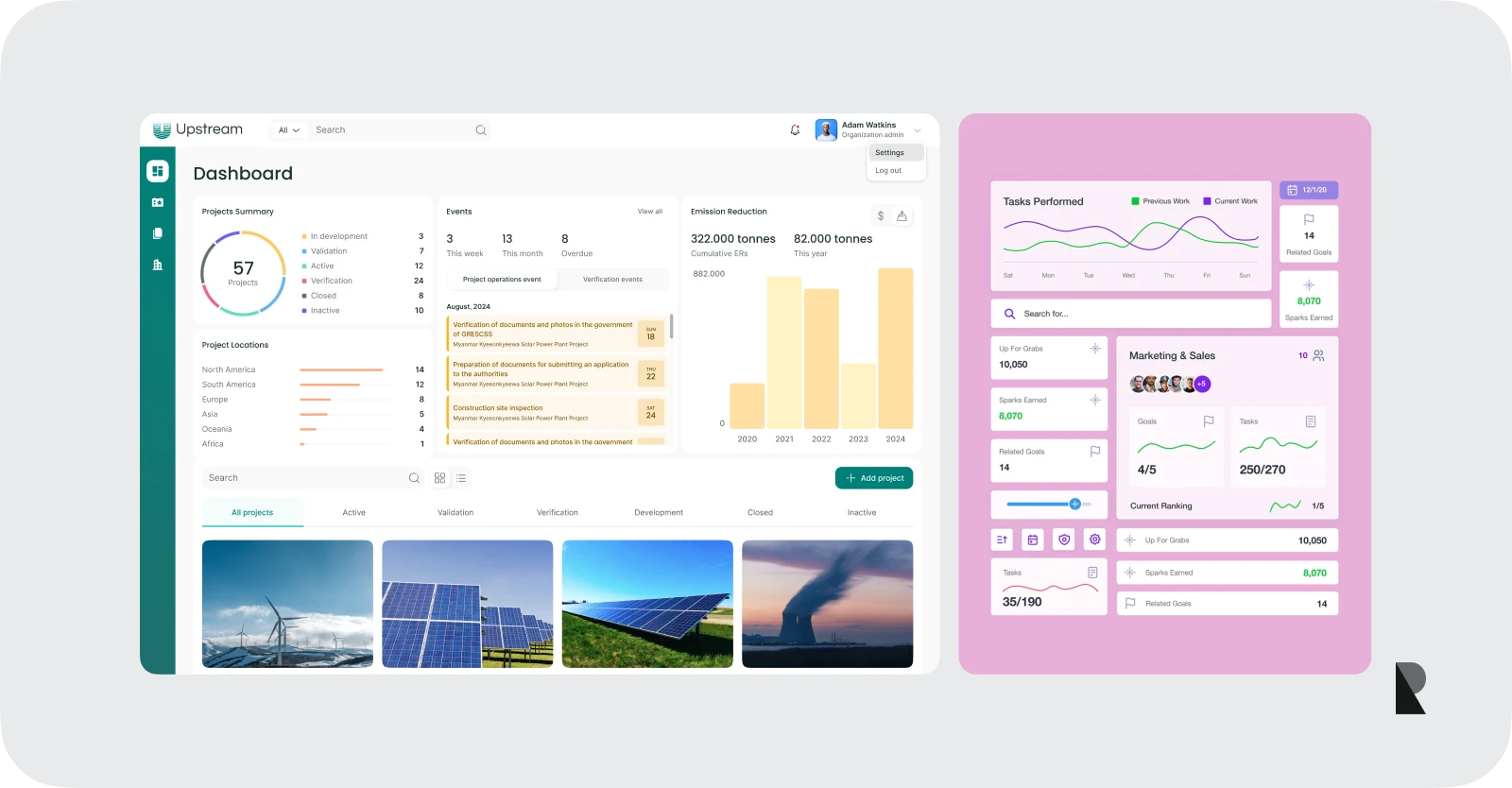
To better understand the scope of digital product design, let’s look at some common examples: Mobile apps are one of the most familiar categories, whether for banking, fitness, or communication. SaaS platforms, used for everything from project management to finance, are digital products requiring carefully planned design and development.
Customer relationship management systems (CRMs) are another example. They must be easy to use, scalable, and tailored to the workflows of sales teams. E-commerce platforms depend heavily on thoughtful product design to simplify user journeys and reduce checkout friction. Even internal B2B tools, often overlooked, need strong design to increase usability and user satisfaction among employees.
Expanding further, consider how government services are now going digital. Tax filing portals, online licensing systems, and healthcare dashboards are digital products. Their usability affects millions of people simultaneously, proving that product design has societal and business implications. Education platforms offer another angle. Student engagement drops when user research highlights pain points like confusing navigation or inconsistent design elements. In contrast, intuitive design encourages learning and improves outcomes.
Why Product Design Matters in Development
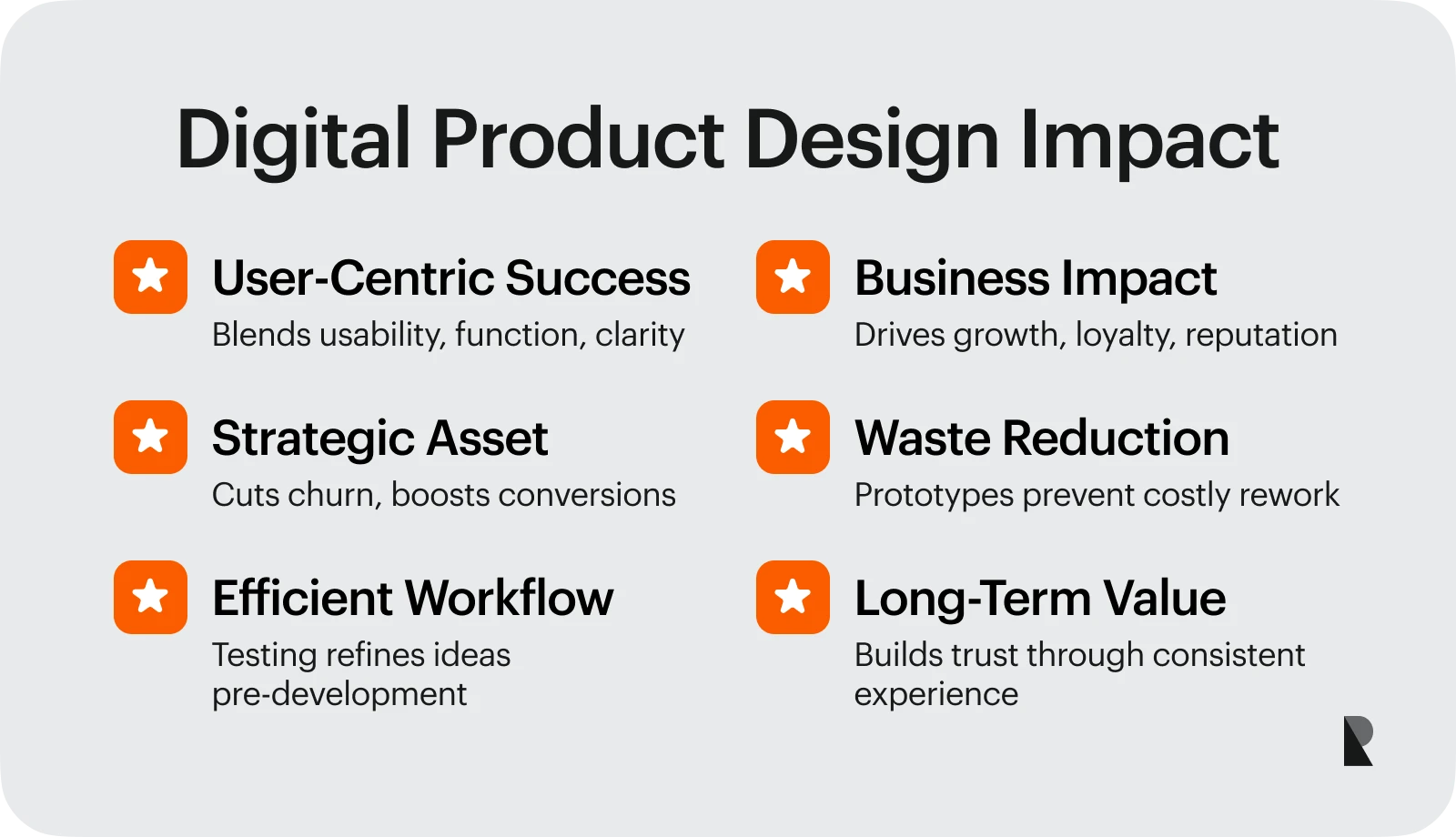
Design plays a central role in determining whether a digital product succeeds or fails. A successful digital product mixes usability, functionality, and visual clarity. Without it, businesses risk losing customers to frustration, poor navigation, or confusing interfaces.
Impact on usability and business goals
Well-executed design drives usability and helps products align better with business goals. Companies that invest in design outperform their peers, where top design performers achieve nearly double the revenue growth and 70% higher shareholder returns than competitors who deprioritize design. Good design turns into good business because it creates user experiences that keep people engaged and loyal.
When design is treated as a strategic asset, businesses gain measurable benefits. Thoughtful product design reduces churn, increases conversion rates, and improves brand reputation. Because design directly influences how people interact with technology, it has a compounding effect: each positive experience increases trust, leading to long-term loyalty.
Reducing development waste
Another reason digital product design is valuable is its ability to reduce waste in product development. Design teams clarify the vision before heavy coding begins when they create prototypes, scenarios, and wireframes early. This prevents wasted time on features nobody wants or interfaces that frustrate the end users.
Prototypes (whether low-fidelity sketches or more detailed wireframes) allow businesses to test ideas quickly. Research and testing at this stage help uncover potential solutions to user pain points and refine them before development. The result is a more efficient workflow that saves money and speeds delivery.
One of the most significant hidden costs in product development is rework. Teams often rewrite features or redesign interfaces after launch because real user feedback wasn’t considered early enough. A user-centric design process anticipates these issues. By gathering feedback throughout the design, businesses save time and resources that would otherwise be wasted on course corrections. This is why prototypes and usability testing are essential checkpoints — not optional extras.
What Does a Digital Product Designer Do?
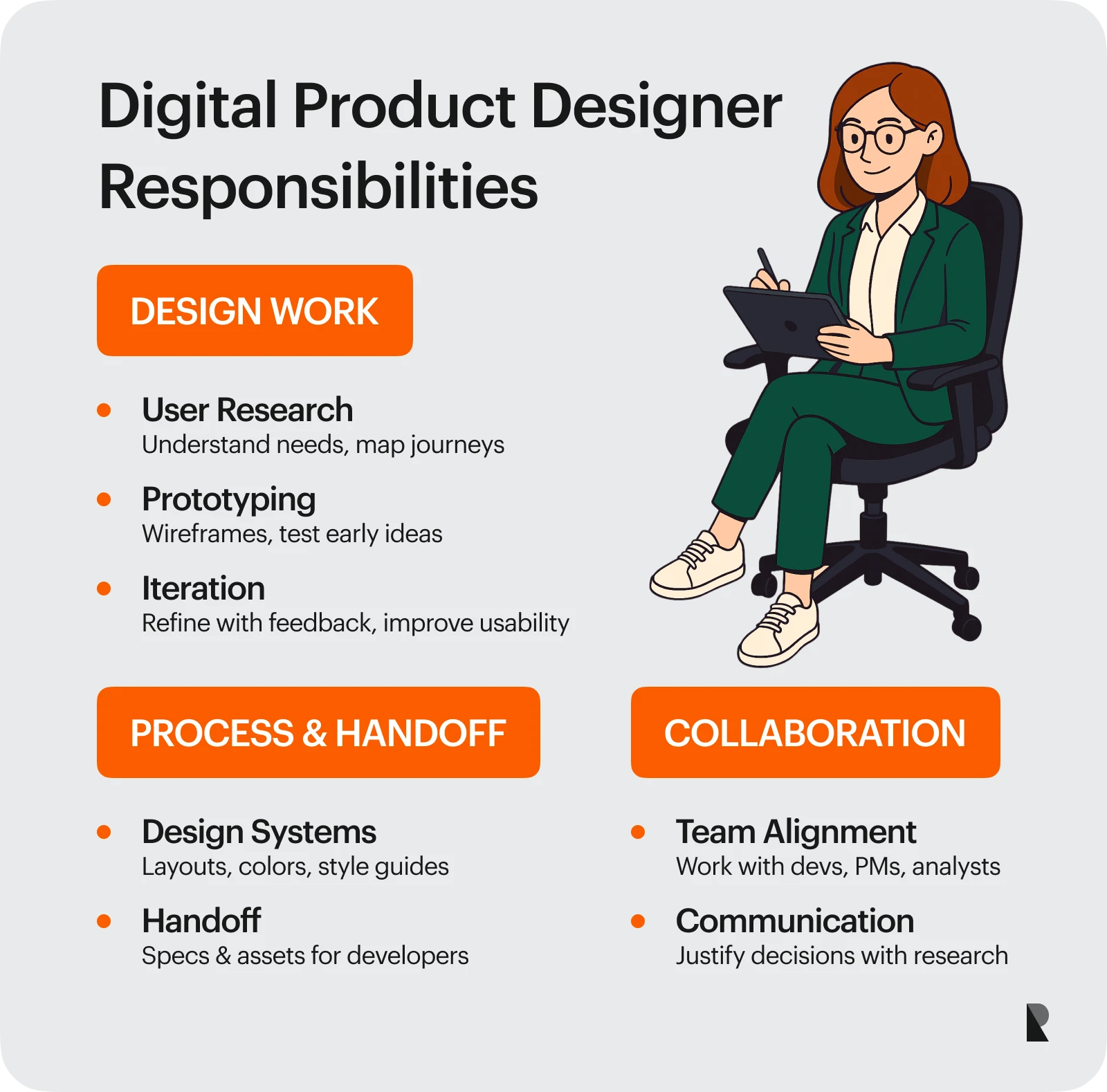
Digital product designers have a multifaceted role that blends creativity with analytical thinking. They are responsible for shaping every aspect of a digital product's appearance, feel, and function.
Key responsibilities
A product designer’s responsibilities often include conducting user research, mapping user journeys, and creating wireframes or prototypes. They define layouts, refine color schemes, and document the design process so that development teams can work with clarity. Testing is also a key responsibility, with product designers using user feedback to iterate and refine designs throughout the design process.
Documentation and handoff are essential as well. Product designers prepare detailed design systems and specifications so that developers can implement solutions without ambiguity. They don’t just stop at wireframes — they build a shared language between design and development. This often involves selecting tools like Figma, Sketch, or Adobe XD to maintain clarity throughout the design process.
Collaboration with teams
Collaboration is at the heart of digital product design. A product designer works closely with developers, project managers, business analysts, and marketers. Strong communication skills are vital — designers must articulate why decisions are made and defend them with research and user feedback.
This collaboration extends across a digital product's lifecycle. From early market research to usability testing, product designers play a central role in aligning teams around user needs and business goals. Their ability to bring cross-functional groups into one shared vision is one of the reasons they are so highly valued in modern product development.
5 Stages of the Product Design Process
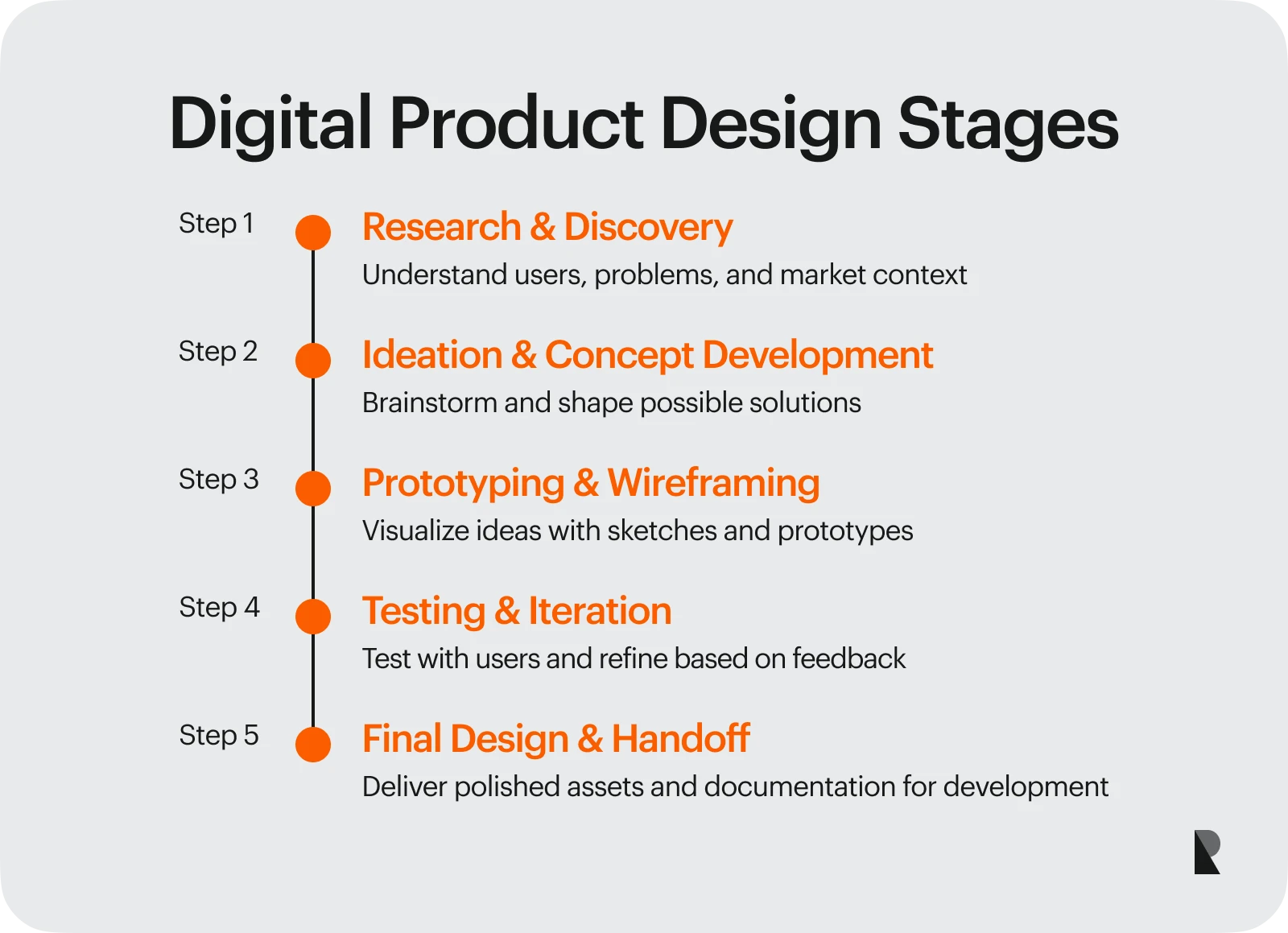
The product design process is structured, but remains flexible. It is iterative, meaning ideas are tested, refined, and tested again until a digital product is launched. Frameworks like the Double Diamond illustrate how designers move between phases of exploration and definition.
1. Research and discovery
The journey begins with research and discovery. Designers conduct interviews, run surveys, and perform competitor analysis to understand the landscape. Behavior analysis and user research uncover pain points and motivations, helping design teams craft user personas representing the target audience.
Expanding this stage, research and discovery also involve studying analytics and observing real-world use of comparable digital products. By reviewing session recordings, heatmaps, or customer feedback channels, designers gain insight into patterns of frustration and delight. Combining qualitative research with quantitative data strengthens the foundation for the design thinking process.
2. Ideation and concept development
Once the research is complete, ideation begins. This is the stage where product designers focus on generating potential solutions. Workshops, journey mapping, and moodboards help to visualize directions. The design thinking process encourages teams to explore broadly before narrowing down ideas that meet user needs and business goals.
3. Prototyping and wireframing
Prototyping and wireframing transform concepts into tangible forms. Low-fidelity sketches provide quick validation, while high-fidelity prototypes bring designs closer to reality. This phase allows teams to align on flows, layouts, and interactions before full product development starts.
4. Testing and iteration
Testing is where designs are validated against real-world use. Usability testing reveals friction points, while structured research and testing cycles provide actionable feedback. Designers incorporate user feedback, improving the product’s usability and refining interaction details. This stage reflects the principle that the design process is never linear — it requires iteration until the product meets user satisfaction.
5. Final design and handoff
The last stage involves preparing production-ready files. This includes component libraries, interaction guidelines, and documentation for developers. A smooth handoff makes it easier for development teams to integrate the design without costly misinterpretations. The product design process concludes here, but iteration continues as new feedback surfaces post-launch.
Core Elements of Digital Product Design
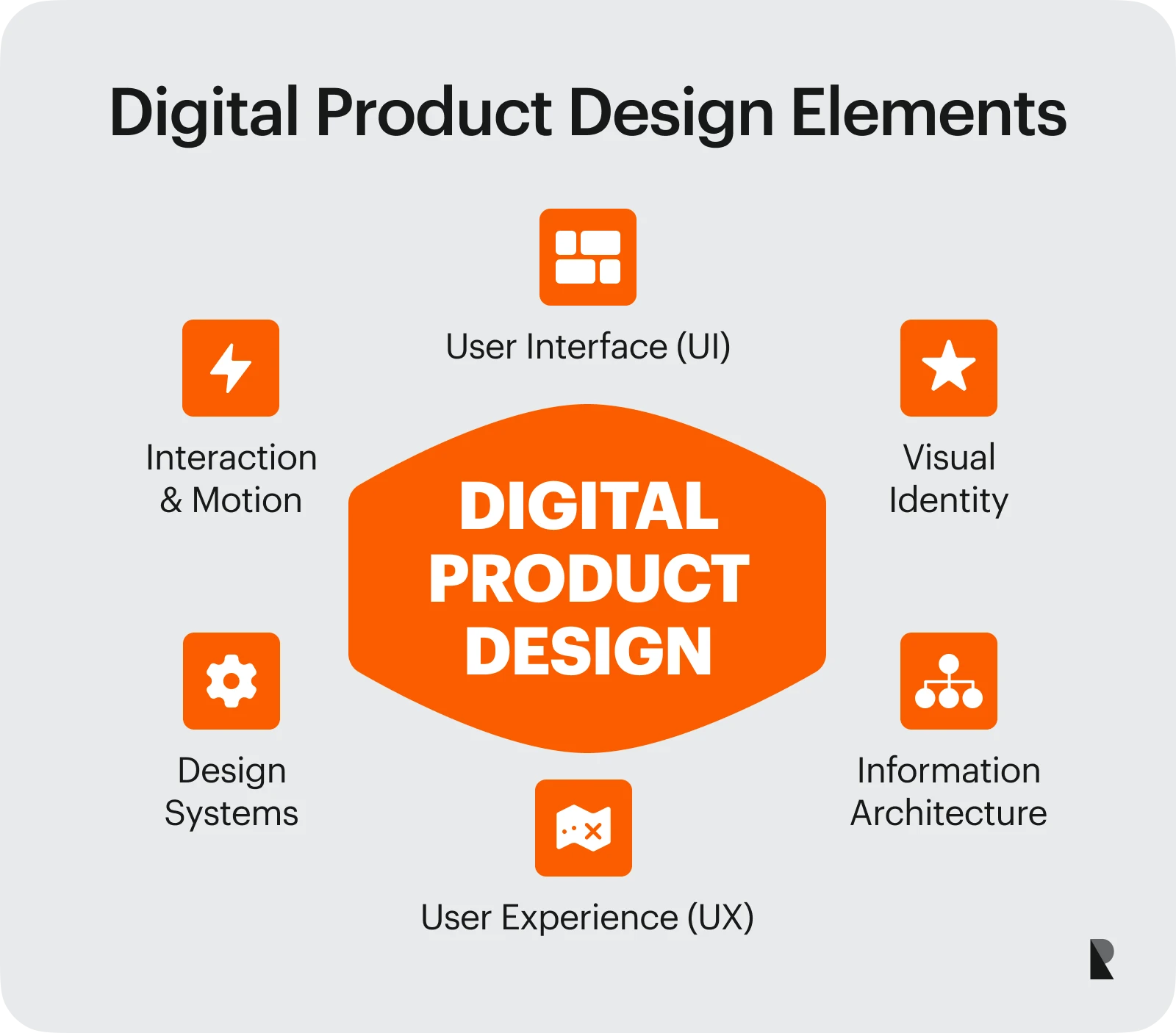
Several core elements must work together seamlessly to create a successful digital product. Each contributes to usability, branding, and the overall user experience.
User interface (UI)
The user interface covers the visual side of design. Buttons, fonts, icons, and color schemes all shape how users perceive the product. A polished UI builds trust, makes a product user-friendly, and communicates brand identity at first glance.
User experience (UX)
User experience defines the structure and logic of interaction. It focuses on navigation, flow, and usability. A well-designed UX anticipates user needs, reduces cognitive load, and creates smooth user journeys. More than 70% of marketers say customers now demand much better digital experiences, underscoring how central UX is to business success.
Interaction and motion design
Interaction and motion design add life to digital products. Micro-interactions — like subtle animation when a button is pressed — provide feedback and guide users without needing explanation. Transitions between screens, progress indicators, or animated illustrations can reduce friction and create a smoother, more engaging user experience.
Motion also communicates hierarchy and context. For example, a sliding panel signals that additional information is related but secondary to the main content. Designers focus on balancing aesthetics with usability, ensuring that animations support comprehension rather than distract. When used thoughtfully, motion can create delight. When used excessively, it tends to overwhelm. The skill lies in designing interactions that feel natural and invisible but still deeply support the user journey.
Visual identity and branding
Every digital product is also a brand touchpoint. How it looks and feels contributes to recognition, trust, and emotional connection. Visual identity includes typography, logos, imagery, and tone of interaction. When applied consistently, these design elements strengthen the brand while making the product memorable.
For example, think of how a music-streaming platform like Spotify is instantly recognizable — not only by its logo but also by its color palette, typography, and interaction design. The product itself communicates the brand.
Information architecture
Information architecture structures content to help users find what they need. Menus, navigation bars, and search functions must be intuitive. Designers use methods like card sorting or tree testing to validate how content should be grouped. Clear architecture reduces frustration, increases user satisfaction, and directly supports usability.
An overlooked benefit of strong information architecture is its impact on business outcomes. Users are more likely to complete their task when they can quickly locate what they need — a product spec sheet, a pricing page, or a customer support option. This translates into fewer drop-offs, faster conversions, and more satisfied customers.
Design systems and libraries
As digital products scale, consistency becomes critical. Design systems provide a library of reusable components — buttons, grids, color palettes, and interaction patterns — that design and development teams can use throughout the design process. This speeds up production and guarantees that the user experience feels unified across different platforms.
Large organizations rely heavily on design systems to maintain coherence across multiple teams. A strong design system supports collaboration, reduces redundant work, and creates scalable frameworks for product development. It also makes onboarding new product designers easier, since they can work within an existing framework rather than starting from scratch.
Product Design vs UX Design
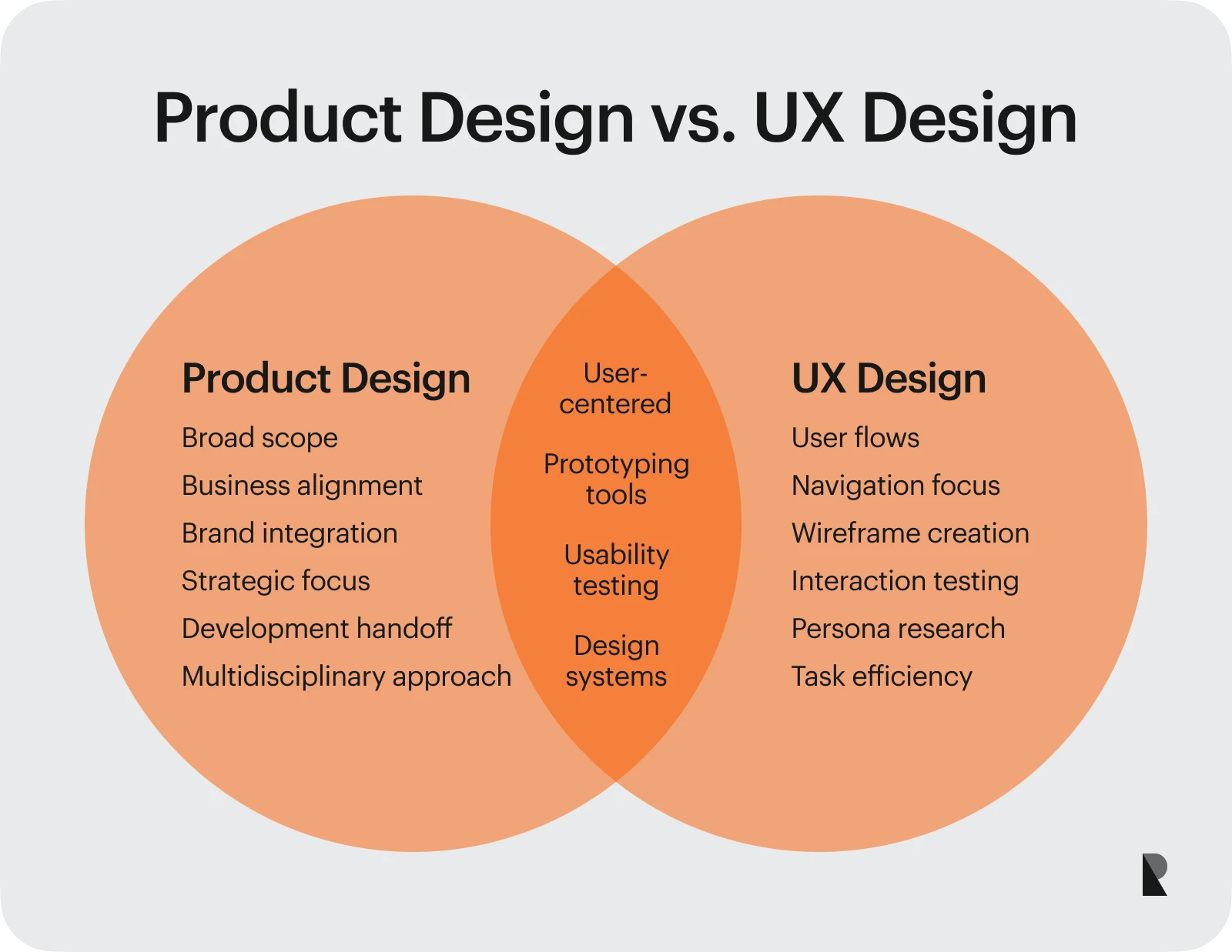
Product and UX design often overlap, but their scope and responsibilities differ significantly. Understanding this distinction helps businesses hire the right expertise for their needs.
Scope and deliverables
UX design centers on user interactions — flows, usability, and testing how users move through a product. Deliverables may include wireframes, user personas, and usability testing results. Product design, on the other hand, takes a broader perspective. It includes UX design but extends into strategy, branding, and alignment with business goals.
Product designers consider how a product feels and how it supports business objectives, integrates with development workflows, and communicates brand identity. Their deliverables range from prototypes to detailed handoff documentation. In short, UX design focuses on usability, while product design includes usability plus the broader business and brand context.
Hiring: UX vs product designer
Businesses should consider their project scope when deciding between hiring a UX designer or a product designer. A UX designer may be sufficient for projects focused primarily on usability, navigation, and testing. However, a product designer might be the better choice for more complex initiatives — where business goals, branding, and design systems need to be integrated.
Many companies partner with a UX design agency to access both skill sets under one roof. Agencies can provide specialists who handle specific stages of the product design process while ensuring that the final output aligns with the overall strategy. This dual approach saves time and reduces the risk of misalignment between design and development.
Digital design agencies
For organizations looking to elevate their product, working with top digital design agencies offers many unique advantages. These agencies combine multidisciplinary teams — including product designers, UX researchers, and brand strategists — who can approach a challenge from multiple angles. They help refine usability and create a product identity that resonates with your target audience and supports long-term business goals.
Digital design agencies also bring established workflows, from market research to usability testing, that accelerate progress without sacrificing quality. Their cross-industry experience allows them to transfer insights from one sector to another, helping companies innovate while avoiding common pitfalls. Maybe most importantly, they act as strategic partners: aligning the product design process with broader business objectives and positioning digital products for sustainable success.
For growing businesses and enterprises, collaborating with an experienced agency means gaining creative talent and a tested process that can scale with your ambition.
3 Common Challenges in Digital Product Design
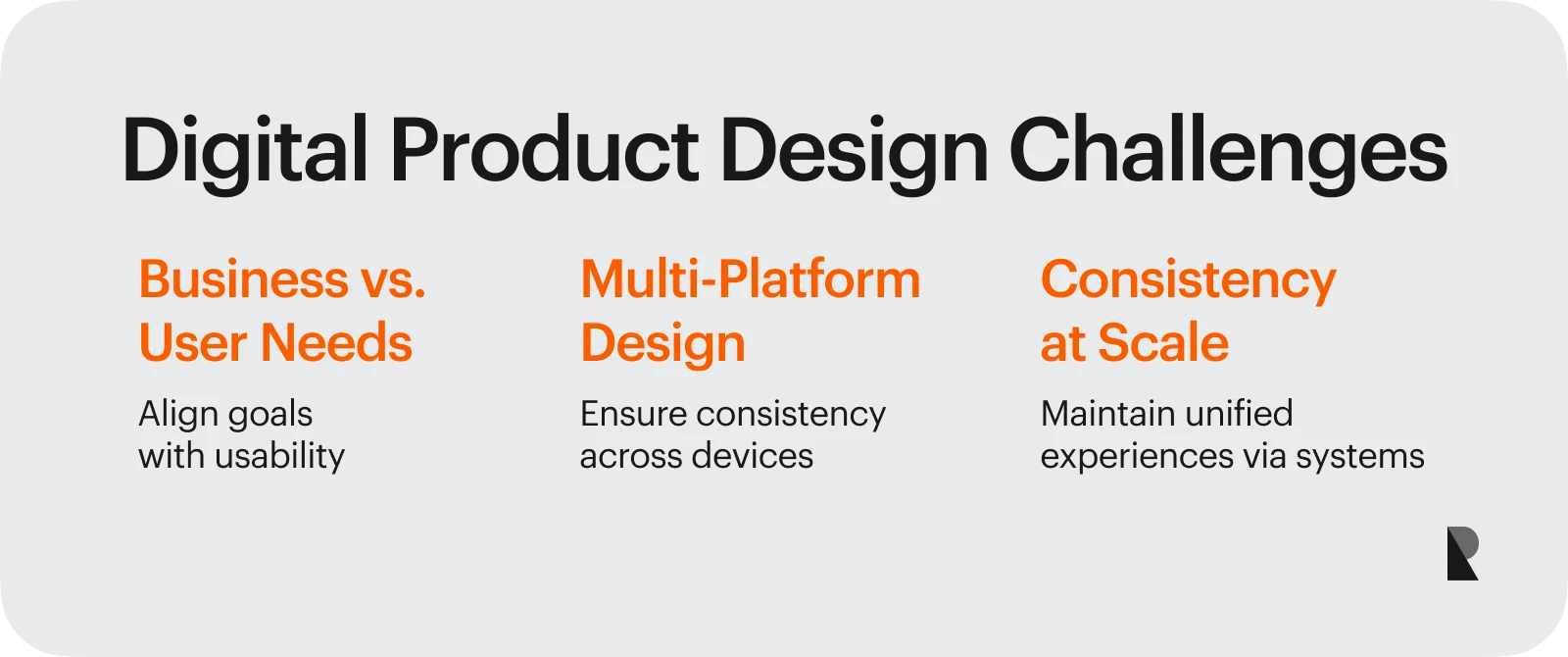
Even with clear processes, digital product design presents many challenges. Designers must balance business needs with user expectations, design for multiple platforms, and maintain consistency across large-scale projects.
1. Balancing business and user needs
One of the biggest challenges is finding harmony between what the business wants to achieve and what users actually need. Business goals often focus on revenue or retention, while users seek simplicity, usability, and satisfaction. A user-centered design approach makes it possible to serve both sides.
By conducting thorough user research and incorporating user feedback throughout the design process, designers create products that meet user needs while achieving strategic outcomes. When done well, this balance doesn’t feel like a compromise — it feels like alignment.
2. Designing for multiple platforms
Another challenge is designing for multiple devices and environments. A mobile app must work seamlessly on iOS and Android, while web applications must be responsive across desktops, tablets, and smartphones. Consistency in usability and visual design is critical, even as the contexts differ.
This requires testing across platforms, using tools like browser simulators and device labs. It also requires designing systems that adapt to varying screen sizes while maintaining brand integrity. This complexity is growing as products now extend into wearables, voice interfaces, and AR/VR experiences. Each platform has unique constraints that must be addressed in the design process.
3. Consistency at scale
Maintaining consistency is complex for large organizations or products with multiple teams. Different design teams may interpret guidelines differently, leading to fragmented user experiences. A robust design system reduces this risk with transparent governance and regular feedback.
Consistency is not just about visuals. It extends to how interactions feel, how error messages are phrased, and how user journeys unfold. Keeping this alignment intact separates a good digital product from a great one. Customers rarely notice when consistency is flawless, but they will instantly notice when it breaks.
Conclusion
Digital product design is a discipline that blends creativity, research, strategy, and technical understanding. It’s the process of creating digital products that feel intuitive, support business goals, and leave users satisfied. Every stage — from research and testing to final handoff — contributes to building digital products that people repeatedly return to.
The evidence is clear: design is a business driver. Companies that prioritize design see higher revenue growth and more substantial shareholder returns. Customers, meanwhile, increasingly demand seamless digital experiences across all platforms. For businesses, investing in product design means investing in long-term success.
A successful digital product requires usability testing, research, clear architecture, and consistent branding throughout the design. If you want that handled the right way from the get-go, partnering with a UX design agency can help your businesses do that while ultimately building user-centric, user-friendly products that align with your vision.
In the end, digital product design is about more than creating tools. It is about shaping user experiences that solve problems, create value, and build trust. Strong product design is not a nice-to-have for any business seeking to stay competitive — it is the foundation of growth and loyalty.
Sep 30, 2025


